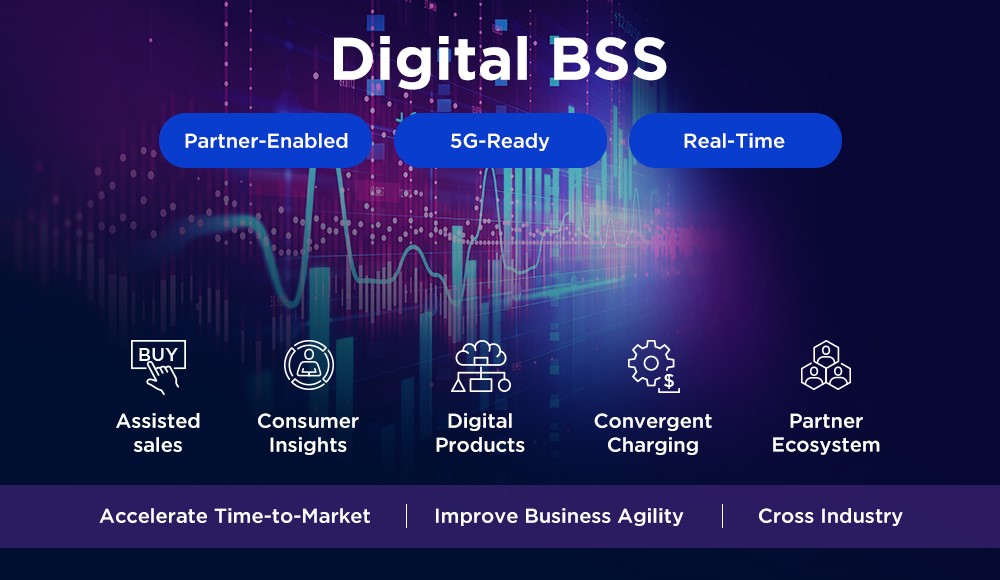We discuss the following topics in this blog:
- BSS for fast-paced business requirements
- CSPs taking on the new avatar of digital service provider (DSP)
- Glancing at the Digital BSS Architecture
- Digital BSS solutions as the future
In addition to these topics, we shall also be answering the following FAQs:
- What is an Optical Fibre Cable?
- What is WiFi?
Contents
What is the Need for an Interactive and Scalable BSS System?
The digital business support system (BSS) is undergoing a substantial digital transformation to meet the fast-paced business requirements. BSS is at the heart of every organization. With rapidly emerging technologies like 5G, the Internet of Things (IoT), and rapidly changing customer behaviours in social media, self-serving apps are forcing service providers to offer an interactive and scalable BSS system.
At present, most organizations have BSS features with legacy modular monolithic architecture and traditional methods, which mainly limit the changing demands. However, BSS has been the backbone of the telecom industry. Telcos or even Communication Service Providers (CSP’s) need to look forward to making this digital transformation journey happen fast. However, this needs a big ‘think over’ in terms of technology and operational wise re-look. CSP’s need to align with mastering technologies like cloud, artificial intelligence (AI), Wi-Fi 6, orchestrate the ecosystem, explore partnership options, and move with agility to meet the market demands.
While we already see the widespread adoption of 5G technologies, operators will need newer capabilities and collaborate with ecosystem partners to meet end-user changing demands in real-time. Besides, over-the-top (OTT) players and social networks such as Apple, Google, and Facebook offering video and voice calls, chats, and other interactive channels need to meet these demands to offer services in matching agility. With cloud solutions all over the place, operators must be ready to provide technology solutions to make a good or the need for a new digital BSS architecture.
Transitioning from CSPs to DSPs
The key now is to adopt a BSS that can offer microservices with modularity at a very micro-scale. Also, digital transformation is an ideal opportunity for operators to rebuild the lost or declining market positions, also innovate, and prepare for the future. In short, CSPs need to take on the new avatar of being a digital service provider (DSP), this change requires a technological, cultural, and operational transformation, extending from the network to the partners. As highlighted, it is imperative that there is a massive revolution in going the digital way, customers, competitors, and future revenues streams will depend on it.
According to a report by The Insight Partners, the digital BSS market was valued at USD 3,265.07 MN in 2019. It is estimated to reach USD 8,017.18 MN by 2027, with a CAGR of 12.1% from 2020 to 2027, with North America experiencing the highest adoption. Future will be on IoT, cloud-based training, and consulting services will play a dominant role in the BSS market. A report by business markets insights indicates that the APAC BSS market was at USD737,7 million in 2019 and is expected to grow to 2,151.01 by 2027 at a CAGR of 14.2% from 2020 to 2027, telcos will be the major players to offer BSS solutions.
Growing concerns in this digital transformation journey are that BSS stacks have miles to go before supporting any digital plans as legacy systems and processes are complex. Operators need to have a plan to leverage these and include BSS to suit all business aspects.
Research firm, Ovum, illustrated artificial intelligence (AI) can enable an operator to improve customer experience and enhance the efficiency of various business processes. However, operators need to invest in IT systems within the BSS framework to leverage it thoroughly, making it lean and agile. These can be done by consolidating systems and automating multiple processes all over the revenue and customer management stacks.
A Brief Look Inside Digital BSS Architecture
A digital BSS solution consolidates backend infrastructure, optimizes interoperability so as to offer enhanced customer experience. The heart of digital BSS sits the BSS API Framework, supporting all API running on different domains. A database is in use to process thousands of requests per second, complimented by the High-Performance Data (HPD) Framework; the BSS API integrates all channels into the shared information layer to deliver a unified communications system modular scalable.
To have the right strategy in place to make the BSS transformation, it is imperative to set the correct expectations from the cloud and selecting a good cloud provider who can define well-planned cloud architecture supported with a good operating model.
A robust and comprehensive digital BSS should have subsystems such as product order management, predictive analytics, and revenue management to manage business processes comprehensively. A well-thought-out dashboard is a critical component that monitors and manages entire BSS operations from a centralized dashboard.
Proper implementation of digital BSS solutions will bring around a new level of intelligence to the business processes. The future of BSS is certain and needs to face challenges in terms of handling large volumes of transactions in real-time and strategizing on revenue sharing models among partners. It is time to say goodbye to legacy BSS and CSPs will need to move in adopting to use the cloud.
Are Digital BSS Solutions the Way Forward?
The telecommunications industry is at a digital transformation point; it is happening fast, with digital BSS solutions all set to disrupt. The theme is to choose the right IT service provider to help make a smooth transition to the digital BSS platform, which mandates BSS systems that are more agile, lean, and designed to support real-time intelligence. Investments to upgrade to the digital BSS stacks will be critical, but it can’t happen overnight; a gradual approach is the best way to gain maximum success.

STL Digital BSS portfolio is engineered for innovation at scale and speed, improved monetisation and mobilizing future-relevant customer-centric platforms. Regardless of their stage or maturity on the Digital Transformation journey, superlative experience and digital engagement for customers and partners is sine qua non for CSPs to thrive in the era of Platformification. Telcos need to elevate their engagement with their vendors, partners and customers by harvesting as Cloud-Native, Micro-services, AI and Automation. And it goes far beyond simply improving interactions across touchpoints along their journeys. That is precisely what differentiates STL Digital BSS Platform solutions from other solutions in the market. Connect with us now.
FAQs
What is an Optical Fibre Cable?
An optical fibre cable is a cable type that has a few to hundreds of optical fibres bundled together within a protective plastic coating. They help carry digital data in the form of light pulses across large distances at faster speeds. For this, they need to be installed or deployed either underground or aerially. Standalone fibres cannot be buried or hanged so fibres are bunched together as cables for the transmission of data. This is done to protect the fibre from stress, moisture, temperature changes and other externalities.
There are three main components of a optical fibre cable, core (It carries the light and is made of pure silicon dioxide (SiO2) with dopants such as germania, phosphorous pentoxide, or alumina to raise the refractive index; Typical glass cores range from as small as 3.7um up to 200um), Cladding (Cladding surrounds the core and has a lower refractive index than the core, it is also made from the same material as the core; 1% refractive index difference is maintained between the core and cladding; Two commonly used diameters are 125µm and 140µm) and Coating (Protective layer that absorbs shocks, physical damage and moisture; The outside diameter of the coating is typically either 250µm or 500µm; Commonly used material for coatings are acrylate,Silicone, carbon, and polyimide). An optical fibre cable is made up of the following components: Optical fibres – ranging from one to many. Buffer tubes (with different settings), for protection and cushioning of the fibre.
Water protection in the tubes – wet or dry. A central strength member (CSM) is the backbone of all cables. Armoured tapes for stranding to bunch the buffer tubes and strength members together. Sheathing or final covering to provide further protection. The five main reasons that make this technology innovation disruptive are fast communication speed, infinite bandwidth & capacity, low interference, high tensile strength and secure communication. The major use cases of optical fibre cables include intenet connectivity, computer networking, surgery & dentistry, automotive industry, telephony, lighting & decorations, mechanical inspections, cable television, military applications and space.
What is WiFi?
Put simply, WiFi is a technology that uses radio waves to create a wireless network through which devices like mobile phones, computers, printers, etc., connect to the internet. A wireless router is needed to establish a WiFi hotspot that people in its vicinity may use to access internet services. You’re sure to have encountered such a WiFi hotspot in houses, offices, restaurants, etc.
To get a little more technical, WiFi works by enabling a Wireless Local Area Network or WLAN that allows devices connected to it to exchange signals with the internet via a router. The frequencies of these signals are either 2.4 GHz or 5 GHz bandwidths. These frequencies are much higher than those transmitted to or by radios, mobile phones, and televisions since WiFi signals need to carry significantly higher amounts of data. The networking standards are variants of 802.11, of which there are several (802.11a, 802.11b, 801.11g, etc.).















